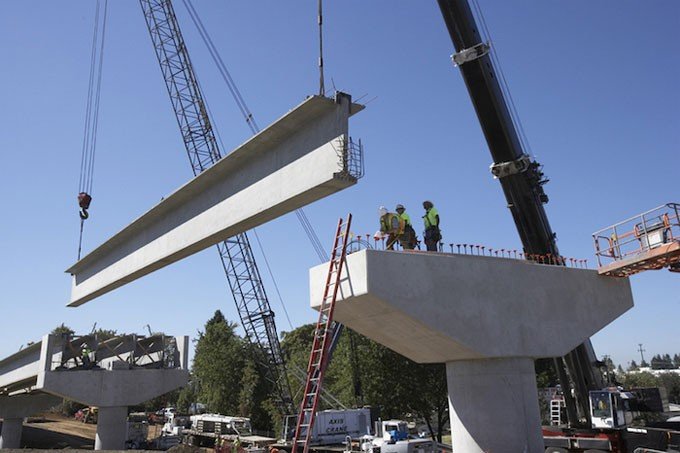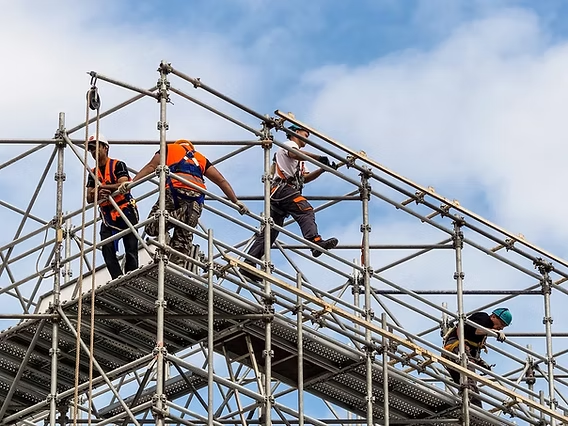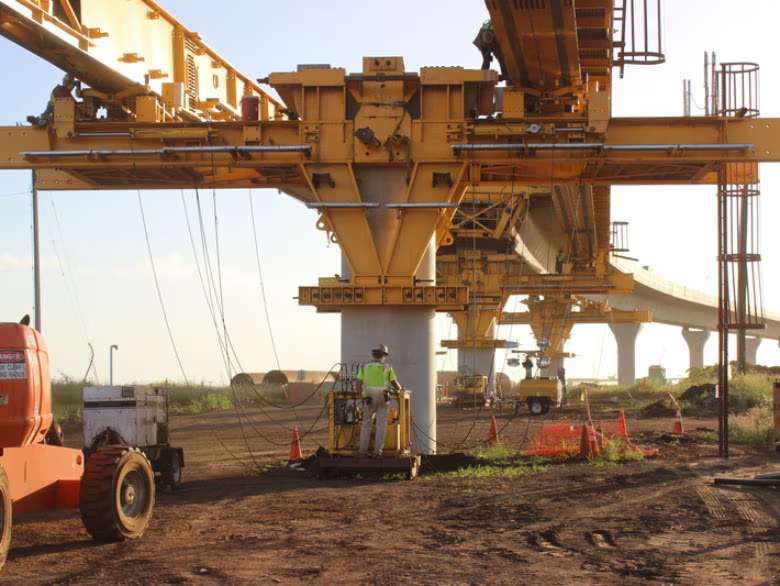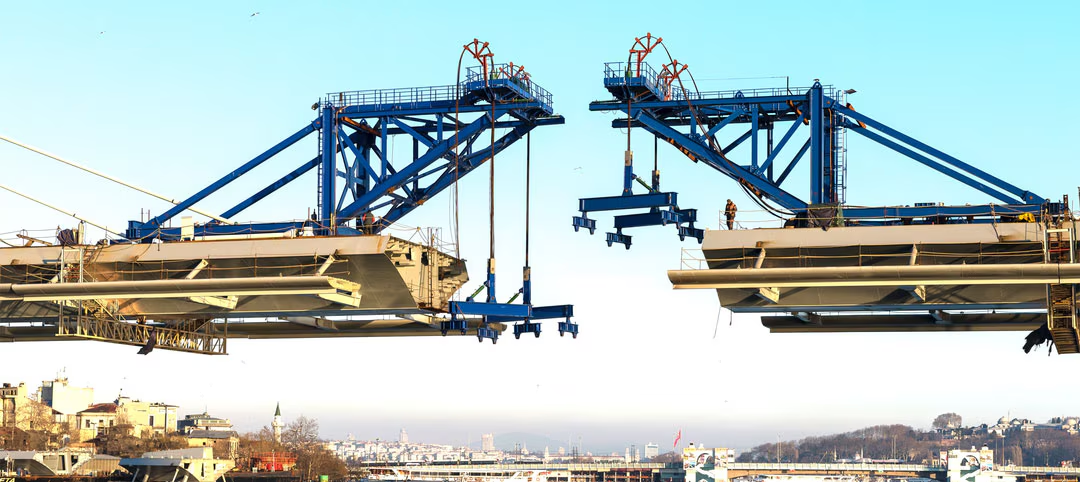What are the most common types of equipment used in bridge construction projects?
Table of Contents
ToggleEquipment used in bridge construction plays a vital role in building strong, safe, and efficient bridges with modern tools and machinery. Bridge construction is a highly technical process that requires the use of advanced equipment to ensure strength, durability, and safety.
Among the most common types of equipment used in bridge projects are cranes, excavators, concrete batching plants, pile drivers, and formwork systems. Cranes are essential for lifting heavy materials like steel beams and precast concrete segments. Excavators are used for site preparation, digging foundations, and handling soil. Pile drivers are critical for installing deep foundations, especially in soft soil conditions, while concrete batching plants provide a consistent supply of high-quality concrete.
Additionally, formwork systems help shape the bridge structure and ensure precision during concrete pouring. Together, these machines form the backbone of bridge construction, allowing engineers and workers to complete projects efficiently and safely.
Why is scaffolding an important equipment in bridge construction?
Scaffolding plays a crucial role in bridge construction because it provides temporary support, access, and safety for workers.
Since bridge construction often involves working at great heights or over water, scaffolding ensures that workers can reach all areas securely while maintaining stability. It is also used as a support structure for formwork during the concrete pouring process. Without scaffolding, it would be extremely difficult to carry out tasks like reinforcing steel installation, inspection, welding, or surface finishing.
Additionally, scaffolding allows safe passage for workers and helps reduce the risk of accidents. Its flexibility and adaptability make it one of the most important pieces of equipment in any bridge construction project.
Proper scaffolding minimizes accidents and enhances productivity. It is a critical part of the equipment used in bridge construction for safety and efficiency. Forever Engineering LTD uses advanced scaffolding systems to guarantee worker safety and precise construction.
What specialized equipment is used for reinforcing steel placement in bridges?
Reinforcing steel, also known as rebar, is vital for providing tensile strength to concrete bridges. Specialized equipment is used to ensure accuracy and efficiency during its placement. Rebar cutting and bending machines help shape the steel into the required design specifications, while rebar tying machines fasten steel bars together quickly and securely.
For large-scale projects, rebar positioning systems and hoisting equipment are used to lift and install heavy reinforcement cages into position. In addition, welding equipment may be used when specific reinforcement connections are required. These tools not only increase productivity but also reduce manual labor, ensuring that the reinforcement is placed precisely according to engineering designs, which enhances the bridge’s strength and durability. Using this equipment reduces human error and speeds up construction. Such tools are essential among the equipment used in bridge construction for reinforced concrete structures.

How is heavy lifting equipment used in bridge construction?
Heavy lifting equipment is indispensable in bridge construction because many of the structural components are massive and cannot be handled manually.
Tower cranes, mobile cranes, gantry cranes, and hydraulic jacks are widely used for lifting beams, girders, precast concrete slabs, and steel segments into place. For large-scale bridges, launching gantries are sometimes used to position precast segments efficiently. Hydraulic jacks also play a critical role in lifting and adjusting bridge decks during installation. These machines are key elements in the equipment used in bridge construction for material handling.
Without such heavy lifting equipment, placing large components with precision would be extremely challenging and dangerous. These machines not only improve speed and accuracy but also enhance worker safety by reducing the risks associated with manual handling of heavy materials.
What types of safety equipment are necessary for workers during bridge construction?
Bridge construction involves working at heights, near traffic, and sometimes over water, making safety equipment a top priority.
Workers are required to wear personal protective equipment (PPE) such as helmets, safety harnesses, gloves, reflective vests, and steel-toed boots. Safety harnesses and lifelines are especially important for those working on scaffolding or elevated areas. In addition, fall protection systems, guardrails, and safety nets help prevent accidents. When welding or cutting steel, eye and face protection gear is essential.
Workers operating heavy equipment also need hearing protection. For projects near or over water, life jackets and rescue equipment are mandatory. By using proper safety equipment, construction companies protect workers, minimize accidents, and ensure compliance with safety regulations.
Using safety equipment prevents injuries and ensures compliance with construction standards. Safety gear is part of the essential equipment used in bridge construction to protect personnel. At Forever Engineering LTD, safety equipment is mandatory on all sites to protect workers and maintain compliance with industry standards.
Which types of piling equipment are essential for bridge foundation work?
Piling is the backbone of any bridge foundation, as it transfers structural loads to deeper, stable soil layers.
Several types of piling equipment are essential in this process. Pile drivers are commonly used to install precast concrete piles, steel H-beams, or timber piles by driving them deep into the ground using impact or vibration. Hydraulic piling rigs are advanced machines that provide accuracy and greater control, making them ideal for modern projects. For soft or waterlogged soils, bored piling machines and rotary drilling rigs are employed to create deep cylindrical shafts filled with reinforced concrete. Efficient piling ensures stability and long-term durability of the structure. Such machinery forms a critical portion of the equipment used in bridge construction for foundation work.
In marine environments, floating piling equipment is often used for installing bridge piers. These machines are indispensable because they ensure the stability, durability, and long-term performance of bridge foundations.

What role do scaffolding and formwork systems play in bridge construction?
Scaffolding and formwork systems are crucial in bridge construction, as they provide both safety and structural support during the building process.
Scaffolding creates safe working platforms for laborers to access elevated sections, enabling them to carry out welding, concreting, or inspection tasks efficiently. It also reduces the risk of falls and accidents, which are common in high-rise or over-water bridge projects.
Formwork systems, on the other hand, are temporary molds used to shape concrete into the desired structural components of a bridge, such as decks, beams, or piers.
Modern formwork systems are made from steel, aluminum, or advanced polymers, ensuring high accuracy and faster installation. Together, scaffolding and formwork ensure construction precision, safety, and speed, making them indispensable for quality bridge building.
They support both the workforce and materials during critical stages. These systems are indispensable elements of the equipment used in bridge construction. Forever Engineering LTD uses high-quality scaffolding and formwork systems to maintain efficiency and reliability.
How are modern technologies, such as automated machinery, improving bridge construction equipment?
Modern technologies have significantly transformed the field of bridge construction, especially through automation and digital integration.
Automated machinery such as robotic welding arms, GPS-guided cranes, and automated rebar tying machines reduces human error and increases speed. 3D concrete printing and automated formwork systems are also emerging technologies that allow for faster and more cost-effective construction.
Another advancement is the use of Building Information Modeling (BIM) integrated with construction equipment, which enables precise planning and reduces waste. Automated monitoring systems are now used to track equipment performance and predict maintenance needs, minimizing downtime.
Additionally, drones and AI-powered surveying equipment have improved site inspections and safety monitoring. These modern technologies not only increase efficiency but also enhance safety and sustainability in bridge construction projects. These technologies enhance efficiency and safety in bridge projects. Modern innovations are transforming the scope of equipment used in bridge construction.

What maintenance is required for equipment used in bridge construction to ensure safety and efficiency?
Bridge construction equipment undergoes heavy workloads, making regular maintenance essential for both safety and efficiency. Preventive maintenance includes lubrication, inspection of hydraulic systems, replacement of worn-out parts, and calibration of sensors to ensure machines operate smoothly. Cranes and lifting equipment require frequent inspection of cables, pulleys, and hooks to avoid accidents. Piling machines and drilling rigs must be checked for alignment, wear on drilling bits, and hydraulic pressure levels.
Safety systems, such as emergency brakes, alarms, and safety switches, should be tested routinely. Scheduled servicing by trained technicians helps extend the life of machinery and prevents costly breakdowns.
Proper documentation of maintenance records also ensures compliance with safety regulations. Ultimately, a proactive maintenance plan reduces downtime, improves efficiency, and protects both workers and equipment. Workers should follow manufacturer guidelines and safety protocols. Proper upkeep is crucial for all equipment used in bridge construction to maintain performance and safety.
Forever Engineering LTD follows strict maintenance schedules to keep all equipment in top condition.
Which types of drilling equipment are commonly used in bridge foundation works?
Drilling equipment plays a central role in bridge foundation work, especially in projects requiring deep foundations.
Rotary drilling rigs are among the most commonly used, capable of boring deep holes for cast-in-situ pile or caissons. Auger drills are useful in soil with medium consistency, while down-the-hole hammers are employed in rocky terrains where extra force is required. For marine bridge foundations, reverse circulation drilling (RCD) rigs are often used, as they are efficient for large-diameter, deep holes underwater. Accurate drilling ensures stability and alignment of bridge supports. Drilling machinery is an essential part of the equipment used in bridge construction for foundations.
In addition, core drilling machines may be used for geotechnical investigations before actual foundation construction. By selecting the right drilling equipment, engineers can ensure that bridge foundations remain stable, durable, and capable of carrying heavy loads.
Conclusion
At Forever Engineering LTD, we understand that the success of any bridge project depends heavily on the quality and efficiency of the equipment used in bridge construction.
From piling rigs, cranes, and drilling machines to scaffolding, formwork, and advanced safety systems, each piece of equipment plays a vital role in ensuring strength, precision, and durability. Modern technologies such as automated machinery and digital monitoring further enhance efficiency, reduce risks, and deliver projects on time. By combining top-quality equipment with expert engineering, Forever Engineering LTD continues to provide reliable, safe, and innovative bridge construction solutions that stand the test of time.

